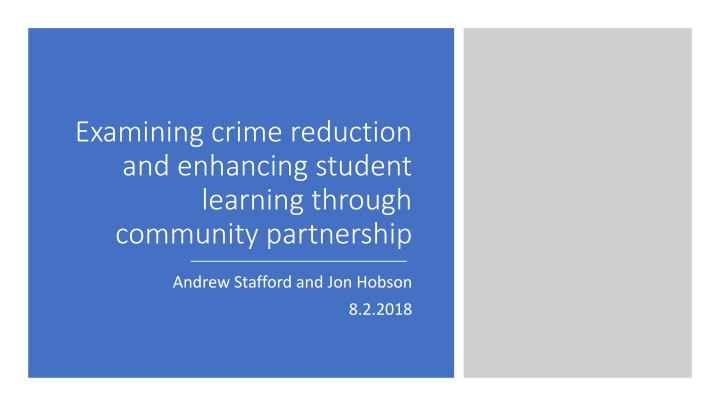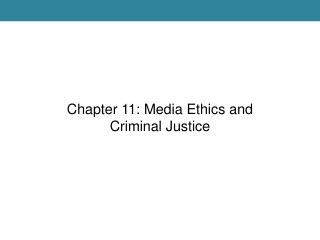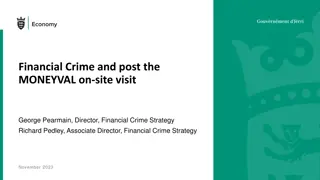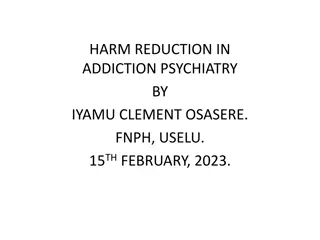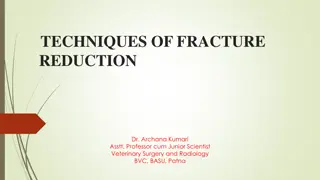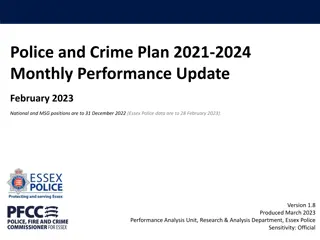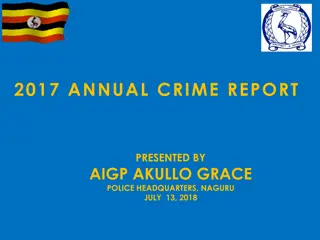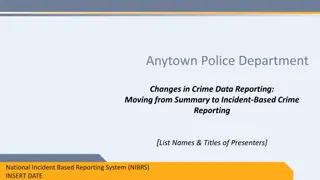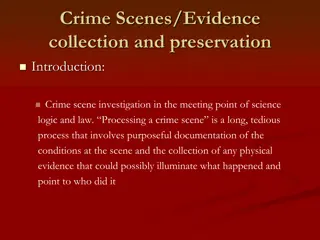Examining Crime Reduction and Enhancing Student Learning Through Community Partnership
This study delves into the partnership between businesses, the community, and educational institutions to tackle crime and disorder in town centers. It emphasizes the importance of combining different data sources to understand and combat prolific offending. The research highlights gaps in current understanding, particularly regarding crimes against businesses. It discusses the challenges and potential effectiveness of Business Crime Reduction Partnerships (BCRPs) in reducing crime in commercial sectors, emphasizing the unique victimization experienced by businesses. The study emphasizes the need for tailored situational measures and collaborative efforts to address crime effectively.
Download Presentation

Please find below an Image/Link to download the presentation.
The content on the website is provided AS IS for your information and personal use only. It may not be sold, licensed, or shared on other websites without obtaining consent from the author.If you encounter any issues during the download, it is possible that the publisher has removed the file from their server.
You are allowed to download the files provided on this website for personal or commercial use, subject to the condition that they are used lawfully. All files are the property of their respective owners.
The content on the website is provided AS IS for your information and personal use only. It may not be sold, licensed, or shared on other websites without obtaining consent from the author.
E N D
Presentation Transcript
Examining crime reduction and enhancing student learning through community partnership Andrew Stafford and Jon Hobson 8.2.2018
1. Tackling crime and disorder in town centres through business community partnership Enhancing student learning through community partnership 2. Overview 3. Combining data to understand and tackle prolific offending
Tackling crime and disorder in town centres through business community partnership Part 1
What do we know about crime and disorder in town centres? Police recorded data facilitates analysis of what the police detect and record. Commercial victimisation survey (CVS) data provides us with insight in to the victimisation experienced by businesses. However, these data only offer part of the picture. For example, CVS data suggests that only 40% of thefts by customers are reported to the police. There remains a gap in the literature, partially a result of criminologists paying little attention to the extent and patterns of crime against businesses (Hopkins and Gill 2017: 389).
We know lots about what works in crime reduction and about the effectiveness of certain tools/techniques employed in town centres. However, despite BCRPs being present in most town centres, there is limited available evidence on their impact or generally on what works in reducing crime against the commercial sector (Hopkins and Gill 2017). It can be difficult to determine whether outcomes are directly attributable to an intervention due to variation in design, scope and implementation (Bullock and Fielding 2017) and a difficulty in isolating causal factors in complex settings (Rosenbaum and Schuck 2012). What do we know about tackling crime through Business Crime Reduction Partnerships (BCRP)?
Stage 1: Consolidating what we know about BCRPs Mechanisms for deterrence and opportunity reduction Platform for collaboration and shared activity Context and environment The victimisation encountered by the commercial sector is unique (Burrows and Hopkins 2005) Crime can be concentrated in particular places (Johnson 2010), and particular shops targeted because of the goods that they carry (Clarke 1999) Robust data collection processes are required that provide insight in to what is happening, when it s happening, who is offending and who is being victimised. Situational measures such as CCTV, tagging of goods, exclusions and information sharing are routinely employed in town centres. The way in which such measures are designed, combined and employed should be appropriate for the unique town centre environment. Such partnerships can be difficult to implement (Tilley 2009), involve an overreliance on technological approaches (Beck 2009) and receive a lack of support from businesses (Mawby 2014). Partnerships must offer platforms that that provide quick and convenient access to information and make sharing information straight forward
Gloucester City Safe Not for profit crime reduction partnership designed to help reduce crime, disorder and anti-social behaviour 140 Members businesses, restaurants, bars, retail establishments and transport services Members commit to using and enforcing an exclusion-based sanction system and have access to an information sharing network Stage 2: Applying this to Gloucester City Safe Multi-year examination of the Scheme Incident data: 4523 incidents captured by the Scheme (1stJune 2014 31stMay 2017) Public surveys conducted in Gloucester City Centre in October 2014 (n=247), October 2015 (n=619) and in October 2016 (n=560). Semi-structured interviews with Scheme members conducted in October 2014 (n=31), October 2015 (n=41), and October 2016 (n=35)
Context and environment There were 1433 offenders in the incident data, but 70 (5%) of offenders committed 1926 (43%) of the incidents. There were c.130 members reporting incidents to the Scheme, but 10 members had together reported 2396 (53%) of all incidents. However, our data also shows that the behaviour of individual offenders doesn t conform to trading hours, can involve more than one kind of offence, and can take place at different kinds of business location.
Whats different about this BCRP? There are many initiatives just for shops, just for pubs, or that just focus on particular types of crime and disorder. The data shows us that there are individuals who are offending across these parameters. There is likely to be value, therefore, in a single crime prevention partnership that is not limited to these parameters, shares information widely, and issues sanctions that can be enforced by all of its members irrespective of opening hours, victimisation type and business classification. Context and environment
Mechanisms for deterrence and opportunity reduction Deterrence and opportunity reduction through the threat/issuing of sanctions: 1223 sanctions were issued to 954 individuals between June 2014 and May 2017. 796 individuals (83% of those who received sanctions) received only one sanction. In 43 of the 107 interviews, a member noted that the warning/exclusion sanction system was a significant mechanism through which they could influence behaviour and control entry to their premises: It does change people s behaviour, certainly people who have yellow cards behave very differently and don t want to be in a situation where they get red cards . (2015) 869 incidents of being on the premises while banned If an incident of being on the premises while banned occurs in isolation, as it did it 395 (45%) instances, then it is arguable that an incident was avoided.
Mechanisms for deterrence and opportunity reduction Issue of prolific offenders The highest number of incidents committed by a single person was 118. 34 individuals (2% of total offenders) had committed 20 or more offences, constituting 1411 (31%) of the total incidents reported. 158 individuals received a second sanction through the Scheme and were then excluded . 59 (37%) of those who received a second sanction did not offend further after its receipt. 99 (63%) offended further after its receipt I think you get less crime from unknow sources, everything that does occur on days especially is from people that you already know about. (2015) This requires further examination
Platform for collaboration and shared activity Quick and convenient information sharing via radios, email and secure web platform. 90 of the 107 respondents discussed how the Scheme helped them to identify individuals who had previously committed sanctionable offences at another member s premises you re more aware of what s going on around. You know about issues before they happen to you (2015) It's an absolutely brilliant Scheme because we can all share information ... it makes it more difficult for them [offenders] to be able to go to other stores and help themselves cause we're all aware of who's out active, whose been locked up (2016) Members are supporting efforts to prevent the crimes that affect others. Scheme data recorded 869 incidents of being on the premises while banned . Any occurrence of being on the premises while banned that occurs at a location other than where an exclusion was issued shows effective information sharing among members.
Platform for collaboration and shared activity Fosters collaboration, cohesion and increased feelings of safety: 62 of the 107 respondents said that membership of the Scheme led to some form of increase in feelings of community or collective responsibility We are part of a community (2014) I work alone in the building, the Scheme makes me feel easier (2014) Perceived as positive and effective by members. 102 of the 107 responses expressed positive sentiments about the Scheme: It s the most positive Scheme that we have ever had in Gloucester ... and seems to have a positive impact on reducing crime . (2016)
Conclusions There is value in running a BCRP with parameters that are broader than those of traditional shop-watch or pub-watch initiatives. There were measurable successes following the threat and issue of an exclusion. Being on the premises while banned in isolation also constitutes a type of success. Collaboration and effective information sharing has helped foster a sense of community and feelings of safety and security for members. The incident data facilitates unique analysis and possibilities for further insight in to crime. The existence of the dataset shows buy in to the mechanism. Although this analysis supports the use of such approaches, further work is required to understand and tackling the issue of prolific offending.
Enhancing student learning through community partnership
Recent emphasis on Universities engaging with communities outside of the Higher Education sector (UUK 2010). This can help ensure that students are gaining the skills and knowledge required to enter employment (Pegg et al. 2012). Such activities can also provide the opportunity for co-produced research. These are projects that facilitate equal partnership in research between at least one academic party and one non-academic party over all phases and aspects of the research from research design, analysis and output (Horner 2016: 8). Community engagement and co- produced research
The co-production of opportunities for research and Community-focused student learning Community-focused learning opportunities our term for the student activities that arise from such collaborations. These are applied student learning experiences that involve working with partners outside of the university and are designed to bring benefits to students and the community partners. There are several such projects across the social science course curriculum, including the collaboration with Gloucester City Safe. This partnership has provided: Students with an insight in to the workings of a crime prevention mechanism, with access to practitioners, and with an opportunity to do applied empirical research. Academic staff with an opportunity to collect data and conduct their own research. The GCS Scheme with detailed insight in to public perceptions of crime and safety and Scheme member perceptions on the Scheme s effectiveness and operation.
Combining data to understand and tackle prolific offending
We are currently negotiating access to a number of datasets to start some experimental research on prolific offending. Gloucester city safe incident data Cheltenham safe data Gloucestershire constabulary crime and intervention data Restorative Gloucestershire data The following slide provides examples of what may be possible from this Understanding and tackling prolific offending
2015 Nov Dec 2015 Feb Mar Apr May Jun Being on the premises while banned. Boots. 08:59 Public Order Offence. Guildhall. 17:55. 2/21/2015 11/17/2014 Being on the premises while banned. Boots. 16:37. 2/21/2015 Arrested. 11/17/2014 Being on the premises while banned. Boots. 10:44. 2/23/2015 Public order offence. Theft. Sports Direct. 16:30. 11/21/2014 Being on the premises while banned. Boots. 14:29. 2/23/2015 Theft. Sports Direct. 13:01. 11/22/2014 Assault. Being on the premises while banned. Bar H20. 21:00. 2/27/2015 Theft. Sainsbury's. 13:15. 11/22/2014 Being on the premises while banned. Boots. 09:35. 3/4/2015 Arrested 11/22/2014 Public order offence. Anti-social behaviour. City Centre. 22:45. Being on the premises while banned. Sainsburys. 14:30. 5/10/2015 12/10/2014 Arrested. Being on the premises while banned. Boots. 15:20. 5/10/2015 12/10/2014 Public Order. Being on the premises while banned. Bar H20. 00:35. Being on the premises while banned. Boots. 11:23. 12/12/2014 5/30/2015 Being on the premises while banned. Boots. 13:25. Public order offence. Assault. Theft. Being on the premises while banned. ASDA. 18:45. 6/5/2015 12/14/2014 Theft. Boots. 10:18. 12/24/2014 Being on the premises while banned. Boots. 13:37 1/21/2015 Being on the premises while banned. Boots. 10:46. 1/22/2015
References Beck, A. 2009. New loss prevention: Redefining shrinkage management. Basingstoke: Palgrave Macmillan. Bullock, K., and Fielding, N. 2017. Community crime prevention , in N. Tilley and A. Sidebottom (eds.) Handbook of crime prevention and community safety . London: Routledge. Burrows, J., and Hopkins, M. 2005. Business and Crime. In N.Tilley (ed.) The Handbook of Crime Prevention. Collumpton: Willan, pp486-515. Clarke, R.V. 1999. Hot products: Understanding, anticipating and reducing the demand for stolen goods. Police Research Series Paper 98. Home office, London. Hopkins, M., and Gill, M. 2017. Business, crime and crime prevention: emerging debates and future challenges , in N. Tilley and A. Sidebottom (eds.) Handbook of crime prevention and community safety . London: Routledge. Horner, L.K. (2016) Co-constructing Research: A Critical Literature Review. AHRC: https://connected-communities.org/index.php/project_resources/coconstructing- research-a-critical-literature-review Johnson, S.D. (2010) A Brief history of crime concentration . European Journal of Applied Mathematics, 21, 349-370. Mawby, R.I. 2014. Commercial burglary. In M.Gill (ed.) The handbook of security (2nd Edn). Basingstoke: Palgrave Macmillan. Pp. 279-301. Pegg, A., & Waldock, J., & Hendy-Issac, S. & Lawton, R. (2012) Pedagogy for employability, The Higher Education Academy: https://www.heacademy.ac.uk/knowledge-hub/pedagogy-employability-2012 Rosenbaum, D.P., and Schuck, A.M. 2012. Comprehensive community partnerships for preventing crime, In B. Welsh and D. farrington (eds) The Oxford handbook of crime prevention. Oxford: Oxford University Press. Pp 291-315. Tilley, N. 2009. Crime prevention. Collumpton: Willan. Universities UK (2010) Universities: engaging with local communities: http://www.universitiesuk.ac.uk/policy-and-analysis/reports/Documents/2010/universities- engaging-with-local-communities.pdf Accessed 4.1.2018.
